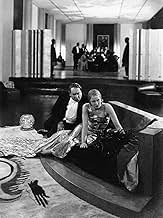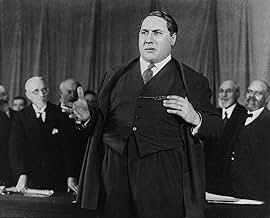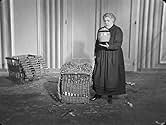L'argent
- 1928
- 3 घं 15 मि
अपनी भाषा में प्लॉट जोड़ेंThe business tycoon Nicolas Saccard is nearly ruined by his rival Gunderman, when he tries to raise capital for his company. To push up the price of his stock, Saccard plans a publicity stun... सभी पढ़ेंThe business tycoon Nicolas Saccard is nearly ruined by his rival Gunderman, when he tries to raise capital for his company. To push up the price of his stock, Saccard plans a publicity stunt involving the aviator Jacques Hamelin flying across the Atlantic to Guyana and drilling ... सभी पढ़ेंThe business tycoon Nicolas Saccard is nearly ruined by his rival Gunderman, when he tries to raise capital for his company. To push up the price of his stock, Saccard plans a publicity stunt involving the aviator Jacques Hamelin flying across the Atlantic to Guyana and drilling for oil there, much to the dismay of Hamelin's wife Line. While Hamelin is away, Saccard t... सभी पढ़ें
- निर्देशक
- लेखक
- स्टार
- Line Hamelin
- (as Mary Glory)
- Massias
- (as Al. Mihalesco)
- Daigremont
- (बिना क्रेडिट के)
फ़ीचर्ड समीक्षाएं
Undoubtedly influenced by Abel Gance's experiments with camera mobility, L'Herbier turned this very free, modern-day version of Zola's celebrated novel into a series of pretexts for outbursts of striking cinematic excess, creating a strikingly modern work marked by its opulent, over-sized sets and a complex, multi-camera shooting style. The result is a film resolutely split between narrative and spectacle, between straightforward storytelling scenes typically dominated by shot-reverse shot cutting and chaotic, exciting impressionist sequences, as when, at the Paris stock market (shot on location) a camera hanging from a pulley apparatus high above the trading floor sweeps down on the traders. The effect, presumable, means to evoke the irrational frenzy of capitalist from a decidedly right-wing perspective.
If Gance's Napoleon and Carl Th. Dreyer's La Passion de Jeanne d'Arc constitute the apex of big-budget historical reconstruction films in the French silent cinema, then L'Argent certainly can be taken as the culmination of the modern studio spectacular. With a five-million franc budget, L'Herbier was given privileged access to the Paris Bourse for three days of shooting (with 1,500 actors and over a dozen cameramen) and was permitted to electrify the Place de l'Opera in order to shoot a night scene of the huge crowd awaiting news of Hamelin's solo transatlantic flight. At the newly opened Studios Francoeur, Lazare Meerson and Andre Barsacq constructed immense set decors, including an enormous bank interior, several large offices and vast apartments, a dance stage for Saccard's celebration party, and an unusual circular room next to Gundermann's office whose entire wall length was covered with a giant world map.
Many of these studio spaces have smooth, polished surfaces and are stylized to the point of exhibiting little more than walls, ceilings, and floors. This stark simplicity, especially in such monumental designs, undermines any appeal to verisimilitude and tends to dissolve the boundaries differentiating one space from another. The indeterminacy of these decors, although exemplary of the modern studio spectacular, thus specifically functions to further abstract the film's capitalist intrigue. Together withe crowds of extras that often traverse the frame and chief cameraman Jules Kruger's selection of slightly wide-angle lenses and high- and low camera positions, especially for the frequent long shots or extreme long shots they produce a consistently deep-space mise-en-scene and larger than life capitalists. Furthermore, the highly stylized or generalized milieu of the film actually serves to foreground the nationalistic and class-based terms of the intrigue, articulated through the casting, and allows them to read all that more clearly.
The Modernizing strategy that shapes L'Argent's set decors and deep-space mise-en-scene was also governed, finally, by a loosely systematic discursive which many French filmmakers shared in the late 1920s. Generally, the French tended to privilege the specifically 'cinematic' elements of framing and editing - close ups (especially of objects), unusually high and low camera position, extensive camera movement, superimposition's and dissolves, various forms of rhythmic montage, associative editing. But L'Herbier's L'Argent offers another, perhaps even more interesting model for the way its reflexive style ultimately helps to articulate the film's critique of capital.
At least two particular features of this film practice loom large in L'Argent. The first feature as an absolutely unprecedented mobile camera strategy, whose high visibility and extreme dynamism render its effect peculiarly ambiguous. The range and extent of the film's camera movement is unmatched except perhaps by that in Gance's Napoleon (for which Kruger was also chief cameraman). Largely because of such unusual camera movements, in L'Argents space oscillates uncannily between the fixed and the fluid. A second feature of the film's discursive practice is its rather unconventional editing patterns, which sometimes work in tandem with camera movement. There is the uniquely persistent pattern of cutting a stable shot as a sudden camera movement becomes perceptible, which creates a slightly jarring effect in the film's rhythm that ruptures its sense of spatio-temporal continuity and foregrounds the very construction of filmic space-time.
The reflexivity of this discursive practice marks L'Argent as a Modernist text, of course, at least to the extent that the materials of the film medium and their deployment as a disruptice system become an ancillary subject of the film. L'Argents framing and editing techniques, in conjunction with set design and acting style or casting, more closely resemble those of Jean Renoir's Nana or Dreyer's La Passion de Jeanne d'Arc, both of which serve to subvert the conventions of another genre, the historical reconstruction. Yet reflexivity here bears a subversive significance that exceeds the genre of the modern studio spectacular precisely because of L'Argent is a story of capital.
L'Argent's achievement, in the end, rests on the correlation it makes between discourse, narrative, and the subject of capital. Capital is both everywhere and nowhere, echoing Marx; it motivates nearly every character in the film and is talked about incessantly, but it is never seen or - as the dung on which life thrives - even scented.
Nevertheless, L'Argent is a beacon of modernity, an over-sized hymn to music of light, where everything is rhythm, movement, and a fantastic spiral of financial manipulations. Even today, the subject is astonishingly relevant.
The film, in the main is about money, of course, the two main characters are Saccard and Gunderman, two financiers. Gunderman is a remarkably well dressed prissy man who is a kind of financial magus, like a Rothschild. Saccard owns a bank but he's down the food chain. Gunderman is intent on persecuting Saccard, we're not totally sure why but Gunderman alludes that he likes financial stability and abhors the destabilising nature of financial speculation. If only Gunderman had been advising the US government in the last few years! However to an extent Gunderman is a bit of a hypocrite as he is using rash speculation to annihilate Saccard.
Saccard uses Hamelin, a dare-devil aviator, to restore confidence in his bank. He arranges a publicity stunt, making Hamelin co-vice-chairman of the board and having him fly off in a plane to break the non-stop solo transatlantic flight record. Once in Guyana, Hamelin is then to set up some oil rigs on land he has options on. The cash from this operation will then restore the fortunes of the Banque Universelle, whilst the publicity stunt will move emotional speculation in BU's favour.
It's a two and a half hour film so there is a lot of plot. What's good though is the way the plot is worked. There is an incredible amount of suspense in the movie, it's dragged out until you're left holding tufts of hair. The level of camera-work is also astonishing, when you watch films from this era you're used to pretty static camera. Well l'Herbier is going bonkers with his camera. He has a vertical camera over the top of the Bourse (Paris stock exchange) swinging about in delirium whilst Hamelin readies to fly away. It's like watching cellular bodies under the microscope, all the little bodies polarised around the nucleus of the central dealing table.
There is a swinging shot of a street crowd that made my jaw drop, and I had to rewind. I suppose the most effectual shot for me though was quite a simple one where he let Hamelin's plane fly of the side of the frame. This is cinematic heterodoxy from what I'm aware. Usually with a shot of a plane you will see it disappear as a dot in the distance or the shot will just cut to another. But you feel a sense of loss as the plane flies off, as it's all cut with shots of Hamelin's wife, you feel what she's feeling, with her husband disappearing off for a desperate maniac flight over the abyssal blue ocean.
L'Argent is also a very glamorous movie, some of the costume jewellery on display in this movie is tres chic! The Baronin Sandorf, a very well cast lady (Brigitte Helm) who really is a human cobra, plays a minor character with Vicar of Bray leanings. She wears a solid gold headpiece and matching earrings at a party that are almost unreal. There's also some costume jewellery that Saccard gives to Line, the wife of Hamelin, that widen the eyes.
As in the early study for this film L'Herbier's 1921 "Prométhée... banquier", we are shown a banker who literally can't get away from his desk, tied down by phone calls, totally unable to give a desperate woman important human news. The movie is, however, not a paroxysm of anti-capitalist rage, it's more of a gorgeous heady melodrama that tries to have it's cake and eat it. However it does lead one's thoughts in the right direction ultimately.
The one real fault I can find with the movie was the ending 10 minutes which were clumsy. It felt like L'Herbier didn't know how to end his film. The very very last scene saved the day a bit.
Pierre Alcover who plays Saccard, the treacherous financier who falls for the hapless heroine whose pilot lover has conveniently flown to Equatorial Guinea to drill for oil, is quite good, but Brigitte Helm, the comely object of his affections is just awful. She's the kind of actress who would overact when pretending to be asleep, and when she is on the brink of suicide she wanders into Saccard's office and stumbles around as if wounded by a sniper's bullet. Saccard looks like the manipulative weasel that he is. He fancies himself as a Napoleon of the financial world but, like Napoleon, he bites off more than he can chew when he locks horns with the urbane Gundermann.
The film does have some saving graces. L'Herbier's use of the camera is sublime, and gives the bored viewer something to concentrate on when the sluggish pace gets too much. Perhaps that is why he chose to film as a silent – the use of sound, while making the story easier to convey, would have restrained the camera and robbed the film of what vitality it possesses. The film does a good job of illustrating the corrupting influence of money, only over-emphasising its message on the rare occasion. As the character's become more depraved and self-absorbed their surroundings become more opulent, their clothes more refined, and it is clear that they are becoming prisoners of their possessions. There's also a great last scene – but you have to wait an unrealistically long time to get to it.
क्या आपको पता है
- ट्रिवियाThere are 1,952 shots in the film, with an average shot length of just six and a half seconds.
- इसके अलावा अन्य वर्जनThe film was shown to the French press in December 1928 in a cut lasting about 3 hours and 20 minutes, however by the time the film had its first public screening in January 1929, producer Jean Sapene had ordered the length to be cut by half, unbeknownst to director Marcel L'Herbier and much to his and fellow filmmaker Marcel Carné's dismay. Much later, the film was restored to a running time of 2 hours and 25 minutes.
- कनेक्शनFeatured in The Twentieth Century: The Movies Learn to Talk (1959)
टॉप पसंद
विवरण
- रिलीज़ की तारीख़
- कंट्री ऑफ़ ओरिजिन
- भाषाएं
- इस रूप में भी जाना जाता है
- Money
- फ़िल्माने की जगहें
- La Bourse, Paris 2, पेरिस, फ़्रांस(interior: shots from the ceiling covering the crowd movement of buying and selling orders)
- उत्पादन कंपनियां
- IMDbPro पर और कंपनी क्रेडिट देखें
बॉक्स ऑफ़िस
- बजट
- FRF 50,00,000(अनुमानित)
- चलने की अवधि
- 3 घं 15 मि(195 min)
- रंग
- ध्वनि मिश्रण
- पक्ष अनुपात
- 1.33 : 1

































